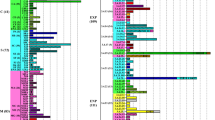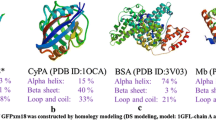Abstract
Serine proteases are an essential and immensely diverse group of enzymes found in many different organisms, from mammals to viruses. Alkaline serine proteases (ASPs) are a type of serine protease that exhibit their highest activity levels in alkaline conditions. These enzymes play a critical role across a wide range of industries, providing immense value and benefits. ASPs are produced mainly by bacteria and fungi on industrial scales. The present study involved an analysis of various sequences of alkaline serine proteases derived from fungi and bacteria. The analytical approach employed encompassed the assessment of the pseudo amino acid composition (PseAAC), the tripeptide composition (TPC), physicochemical properties, secondary structures, and conserved motifs. Motif discovery and analysis showed that a considerable majority of bacterial alkaline serine protease sequences (over 94%) and fungal alkaline serine protease sequences (99%) in the dataset were associated with the subtilisin-like serine protease superfamily. This finding highlights the prevalence of this particular superfamily in alkaline serine protease sequences and provides valuable insight into the evolutionary relationships between different protease families. Based on the results of the study, the utilization of PseAAC and TPC techniques was successful in categorizing fungal and bacterial ASPs into separate groups. This was made possible by precise predictive models generated using machine learning algorithms. Bacterial and fungal ASPs had no significant differences in amino acid composition, ProtParam features, and GORIV secondary structure prediction outcomes. This underscores the importance of TPC and PseAAC concepts in accurately clustering and predicting ASP sequences.




Similar content being viewed by others
Data Availability
The data used to support the findings of this study are mostly available in the manuscript, further information is available from the corresponding author upon request.
References
Akbar S, Khan S, Ali F, Hayat M, Qasim M, Gul S (2020) iHBP-DeepPSSM: Identifying hormone binding proteins using PsePSSM based evolutionary features and deep learning approach. Chemom Intell Lab Syst 204:104103
Ao C, Gao L, Yu L (2020) Identifying G-protein coupled receptors using mixed-feature extraction methods and machine learning methods. IEEE Access. https://doi.org/10.1109/ACCESS.2020.2983105
Ariaeenejad S, Mousivand M, Moradi Dezfouli P, Hashemi M, Kavousi K, Hosseini Salekdeh G (2018) A computational method for prediction of xylanase enzymes activity in strains of Bacillus subtilis based on pseudo amino acid composition features. PLoS ONE 13(10):e0205796. https://doi.org/10.1371/journal.pone.0205796
Bailey TL, Johnson J, Grant CE, Noble WS (2015) The MEME suite. Nucl Acids Res 43(W1):W39–W49. https://doi.org/10.1093/nar/gkv416
Chetal G, Verma ML (2023) Chapter 4-In silico approaches for the quest of the novel enzymes. In: Kuddus M and Ramteke P (eds), Value-addition in agri-food industry waste through enzyme technology. Academic Press, pp 65–78. https://doi.org/10.1016/B978-0-323-89928-4.00017-1
Du PF, Zhao W, Miao YY, Wei LY, Wang L (2017) UltraPse: a universal and extensible software platform for representing biological sequences. Int J Mol Sci. https://doi.org/10.3390/ijms18112400
Duvaud S, Gabella C, Lisacek F, Stockinger H, Ioannidis V, Durinx C (2021) Expasy, the swiss bioinformatics resource portal, as designed by its users. Nucl Acids Res 49(W1):W216–W227. https://doi.org/10.1093/nar/gkab225
Fu L, Niu B, Zhu Z, Wu S, Li W (2012) CD-HIT: accelerated for clustering the next-generation sequencing data. Bioinformatics 28(23):3150–3152. https://doi.org/10.1093/bioinformatics/bts565
Gurung AB (2020) In silico structure modelling of SARS-CoV-2 Nsp13 helicase and Nsp14 and repurposing of FDA approved antiviral drugs as dual inhibitors. Gene Rep 21:100860
Harwood CR, Kikuchi Y (2022) The ins and outs of Bacillus proteases: activities, functions and commercial significance. FEMS Microbiol Rev 46(1):fuab046. https://doi.org/10.1093/femsre/fuab046
Hoo ZH, Candlish J and Teare D (2017) What is an ROC curve? BMJ Publishing Group Ltd and the British Association for Accident, vol 34, pp 357–359
Larder CE, Iskandar MM, Sabally K, Kubow S (2022) Complementary and efficient methods for di-and tri-peptide analysis and amino acid quantification from simulated gastrointestinal digestion of collagen hydrolysate. LWT 155:112880
Linz B, Sharafutdinov I, Tegtmeyer N, Backert S (2023) Evolution and role of proteases in campylobacter Jejuni lifestyle and pathogenesis. Biomolecules 13(2):323
Liu B, Gao X, Zhang H (2019) BioSeq-Analysis2.0: an updated platform for analyzing DNA, RNA and protein sequences at sequence level and residue level based on machine learning approaches. Nucl Acids Res 47(20):e127–e127. https://doi.org/10.1093/nar/gkz740
Long H, Liao B, Xu X, Yang J (2018) A hybrid deep learning model for predicting protein hydroxylation sites. Int J Mol Sci. https://doi.org/10.3390/ijms19092817
Luo J, Wu M, Gopukumar D, Zhao Y (2016) Big data application in biomedical research and health care: a literature review. Biomed Inform Insights 8:1–10. https://doi.org/10.4137/bii.S31559
Matkawala F, Nighojkar S, Kumar A, Nighojkar A (2021) Microbial alkaline serine proteases: production, properties and applications. World J Microbiol Biotechnol 37(4):63. https://doi.org/10.1007/s11274-021-03036-z
Mei J, Zhao J (2018a) Analysis and prediction of presynaptic and postsynaptic neurotoxins by Chou’s general pseudo amino acid composition and motif features. J Theor Biol 447:147–153. https://doi.org/10.1016/j.jtbi.2018.03.034
Mei J, Zhao J (2018b) Prediction of HIV-1 and HIV-2 proteins by using Chou’s pseudo amino acid compositions and different classifiers. Sci Rep. https://doi.org/10.1038/s41598-018-20819-x
Mistry J, Chuguransky S, Williams L, Qureshi M, Salazar GA, Sonnhammer ELL, Tosatto SCE, Paladin L, Raj S, Richardson LJ, Finn RD, Bateman A (2021) Pfam: the protein families database in 2021. Nucl Acids Res 49(D1):D412–D419. https://doi.org/10.1093/nar/gkaa913
Mousavizadegan M, Mohabatkar H (2018) Computational prediction of antifungal peptides via Chou’s PseAAC and SVM. J Bioinform Comput Biol 16(04):1850016
Muszewska A, Stepniewska-Dziubinska MM, Steczkiewicz K, Pawlowska J, Dziedzic A, Ginalski K (2017) Fungal lifestyle reflected in serine protease repertoire. Sci Rep 7(1):9147. https://doi.org/10.1038/s41598-017-09644-w
Nahm FS (2022) Receiver operating characteristic curve: overview and practical use for clinicians. Korean J Anesthesiol 75(1):25–36
Oda K, Dunn BM, Wlodawer A (2022) Serine-carboxyl peptidases, sedolisins: from discovery to evolution. Biochemistry 61(16):1643–1664. https://doi.org/10.1021/acs.biochem.2c00239
Patel AK, Dong C-D, Chen C-W, Pandey A and Singhania RR (2023). Chapter 3 - Production, purification, and application of microbial enzymes. In Brahmachari G (ed), Biotechnology of Microbial Enzymes (Second Edition). Academic Press, pp 25–57. https://doi.org/10.1016/B978-0-443-19059-9.00019-0
Paysan-Lafosse T, Blum M, Chuguransky S, Grego T, Pinto BL, Salazar GA, Bileschi ML, Bork P, Bridge A, Colwell L, Gough J, Haft DH, Letunić I, Marchler-Bauer A, Mi H, Natale DA, Orengo CA, Pandurangan AP, Rivoire C, Bateman A (2023) InterPro in 2022. Nucl Acids Res 51(D1):D418–D427. https://doi.org/10.1093/nar/gkac993
Potter SC, Luciani A, Eddy SR, Park Y, Lopez R, Finn RD (2018) HMMER web server: 2018 update. Nucl Acids Res 46(W1):W200–W204
Qiu J, Wilkens C, Barrett K, Meyer AS (2020) Microbial enzymes catalyzing keratin degradation: classification, structure, function. Biotechnol Adv 44:107607. https://doi.org/10.1016/j.biotechadv.2020.107607
Rawlings ND, Barrett AJ, Finn R (2016) Twenty years of the MEROPS database of proteolytic enzymes, their substrates and inhibitors. Nucl Acids Res 44(D1):D343–D350
Mohamed ME, and Thompson JD (2016) Motif discovery in protein sequences. In: Pattern Recognition - Analysis and Applications. IntechOpen. https://doi.org/10.5772/65441
Satala D, Bras G, Kozik A, Rapala-Kozik M, Karkowska-Kuleta J (2023) More than just protein degradation: the regulatory roles and moonlighting functions of extracellular proteases produced by fungi pathogenic for humans. J Fungi 9(1):121
Sharma N, Thakur N, Raj T, Savitri, Bhalla TC (2017) Mining of Microbial Genomes for the Novel Sources of Nitrilases. Biomed Res Int. https://doi.org/10.1155/2017/7039245
Solanki P, Putatunda C, Kumar A, Bhatia R, Walia A (2021) Microbial proteases: ubiquitous enzymes with innumerable uses. 3 Biotech 11(10):428. https://doi.org/10.1007/s13205-021-02928-z
Upadhyay SK, Gautam P, Pandit H, Singh Y, Basir SF, Madan T (2012) Identification of fibrinogen-binding proteins of Aspergillus fumigatus using proteomic approach. Mycopathologia 173:73–82
Wang X, Qin X, Tong L, Zheng J, Dong T, Wang X, Wang Y, Huang H, Yao B, Zhang H (2023) Improving the catalytic activity of a detergent-compatible serine protease by rational design. Microb Biotechnol. https://doi.org/10.1111/1751-7915.14218
Yao J, Wlodawer A, Guo H (2013) Understanding the autocatalytic process of pro-kumamolisin activation from molecular dynamics and quantum mechanical/molecular mechanical (QM/MM) free-energy simulations. Chemistry 19(33):10849–10852. https://doi.org/10.1002/chem.201301310
Acknowledgements
This work was supported by the University of Isfahan, Iran. We would like to thank Kiarash Shamardani for the copy editing of the manuscript.
Funding
The authors received a research grant from the University of Isfahan.
Author information
Authors and Affiliations
Corresponding author
Ethics declarations
Competing interests
The authors have no competing interests to declare.
Ethical Approval
No human or animal was involved in this study and no informed consent was needed.
Rights and permissions
Springer Nature or its licensor (e.g. a society or other partner) holds exclusive rights to this article under a publishing agreement with the author(s) or other rightsholder(s); author self-archiving of the accepted manuscript version of this article is solely governed by the terms of such publishing agreement and applicable law.
About this article
Cite this article
Mousavi, S.E., Mohabatkar, H. & Behbahani, M. Comparative in Silico Analysis of Fungal and Bacterial Alkaline Serine Proteases: Insights into Structure, Function, and Evolution. Iran J Sci 48, 9–16 (2024). https://doi.org/10.1007/s40995-024-01582-3
Received:
Accepted:
Published:
Issue Date:
DOI: https://doi.org/10.1007/s40995-024-01582-3




